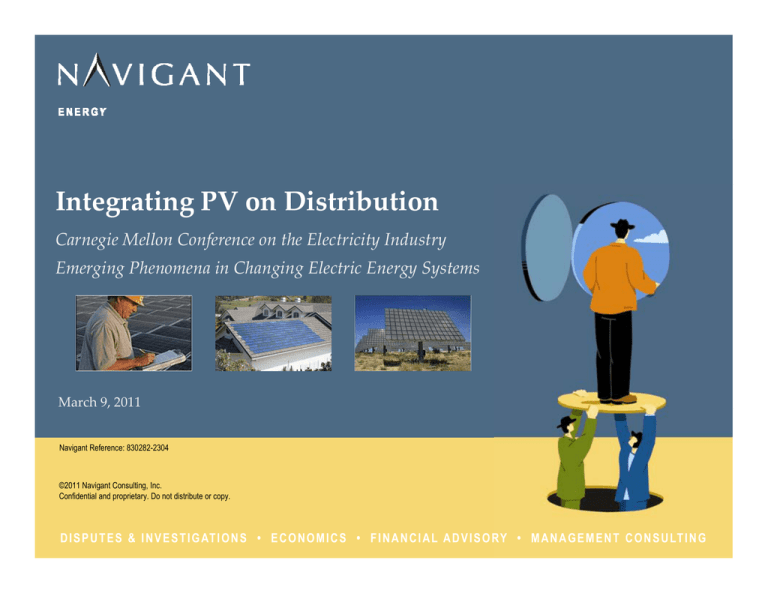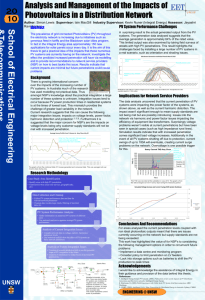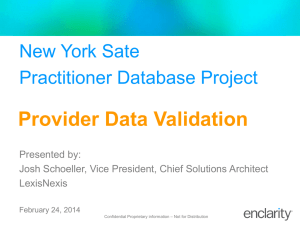Integrating PV on Distribution
advertisement

Integrating PV on Distribution Carnegie Mellon Conference on the Electricity Industry Emerging Phenomena in Changing Electric Energy Systems March 9, 2011 , Navigant Reference: 830282-2304 ©2011 Navigant N i t Consulting, C lti Inc. I Confidential and proprietary. Do not distribute or copy. D I S P U T E S & I N V E S T I G AT I O N S • E C O N O M I C S • F I N A N C I A L A D V I S O RY • M A N A G E M E N T C O N S U LT I N G Discussion Points Points to discuss today » Distributed PV increasing g p » Effects of high penetrations of distributed PV » Energy storage and distributed PV ©2011 Navigant Consulting, Inc. Confidential and proprietary. Do not distribute or copy. 1 ENERGY Growing PV Installed Base PV installations are increasing dramatically, and will exceed annual wind installations by 2013. wind installations by 2013. Annual Renewable Energy Capacity Additions (MW per year) 12,000 10,000 Hydro 8 000 8,000 Geothermal 6,000 Landfill Gas Biomass 4,000 Solar 2,000 Wind 0 2010 2011 2012 2013 2014 2015 Forecasts assume: no renewal of existing federal tax credits after their current expiration dates; and no new federal stimulus program is created. Source: Navigant Consulting, Inc., January 2009. Note: Solar includes solar PV and CSP; Biomass includes biomass co‐firing. ©2011 Navigant Consulting, Inc. Confidential and proprietary. Do not distribute or copy. 2 ENERGY Solar Ownership by Utilities Utilities want to install distributed solar on a large scale and put it in ratebase. Utility Programs for Distributed PV: Examples of Filings for Rate Basing Filed February 2010 3 MW Filed February 2009 500MW in 5 years3 Filed June 2008 20MW in 2 years, Modified to 10 MW Proposed 4Q 2008 5MW Filed February 2009 120MW in 5 years Filed March 2008 250MW in 5 years, Modified to 500 MW3 Filed November 2007 3.5MW in 5 years2 A Sempra Energy Utility Filed July 2008 77MW in 4 years1 Filed May 2009 1.5 MW Filed January 2010 y 80 MW Filed May 2008 y 35MW Program Additional Utility Programs; 3rd party or community owned Sacramento Municipal Utility District (1MW) , Portland General Electric (>2MW), Hawaii Electric Company (16 MW), City of Ellensburg (<1 MW) City of St George (<1 MW) Ellensburg (<1 MW), City of St. George (<1 MW) Notes: 1. SDG&E: 55MW owned by utility 2. ACE: 0.5MW will be utility owned and located on utility facilities. 3. PG&E and SCE 50% ownership ©2011 Navigant Consulting, Inc. Confidential and proprietary. Do not distribute or copy. 3 ENERGY Connecting PV on Distribution Distributed PV can be connected at three points in the distribution system depending on the location and size of the installation. system depending on the location and size of the installation. Distributed PV can by interconnected at three levels Substation PV Primary Distribution interconnection Primary Distribution interconnection assumes that the PV is connected directly to the distribution system, and is not integrated with a customer’s electrical system system. PV Distribution Circuits Substation interconnection assumes that the PV is physically located close to the substation and a dedicated electrical substation, and a dedicated electrical connection to the low side bus would be made. Dedicated Metering PV Net Metering “Behind the meter” Behind the Meter interconnection assumes the PV is integrated with a customer’s electrical system and either net metering or electrical system, and either net metering or dedicated metering could be employed. Each point has a practical limit based on the impact of the PV on the di ib i distribution system. ©2011 Navigant Consulting, Inc. Confidential and proprietary. Do not distribute or copy. 4 ENERGY Challenges of High PV Penetration In addition to high cost, T&D concerns, communications, and regulatory challenges have limited the PV deployed in the past. regulatory challenges have limited the PV deployed in the past. Challenges of High PV Penetration Voltage regulation (D) Reverse power flow (D) Transmission and Distribution Concerns Power fluctuation/frequency regulation (T) q y g Harmonics (D) Lack of communications throughout the distribution system Communications Inverter operating limits (e.g., IEEE 1547) Limited ability to forecast PV resource for capacity planning Non standard communications protocols Non‐standard communications protocols Regulatory and Business Models ©2011 Navigant Consulting, Inc. Confidential and proprietary. Do not distribute or copy. Unstructured interconnection standards and ownership control in some states y y Lack of rate recovery and PV‐“friendly” tariffs 5 ENERGY Transmission and Distribution Performance Concerns Past research had indicated that distribution performance may degrade if PV exceeded certain penetrations on distribution circuits. if PV exceeded certain penetrations on distribution circuits. Recommended Limitations on PV Penetration Based On T&D Performance Concerns T&D T&D Performance Concerns Description of Impact Recommendation e o e a io for Maximum PV Penetration on Circuit Peak Load Voltage V l Regulation Adequate voltage regulation may be difficult due to changes in circuit load and power flow while PV is producing. Also of i i l d d fl hil PV i d i Al f concern is voltage depression after a circuit restoration, when load is restored but PV systems have not come back online. < 40% Reverse Power Flow Changes in PV output can cause the power flow on distribution circuits to vary and in some high generation/low distribution circuits to vary, and in some high generation/low load cases, the flow could reverse. 5% to 30% 5% to 30% Power Fluctuation/ Frequency Regulation The variability of PV output due to cloud transients has been shown to create power fluctuations, and may be incompatible with the ramp rates of some central station generation. This p g variability may require higher levels of system frequency regulation, increasing the cost of accommodating higher penetrations of PV. 5% to 30% 5% to 30% Source: Distributed Photovoltaic Systems Design and Technology Requirements, C. Whitaker, J. Newmiller, M. Ropp, and B. Norris, February 2008 2008, and Navigant analysis, 2008. dN i l i 2008 ©2011 Navigant Consulting, Inc. Confidential and proprietary. Do not distribute or copy. 6 ENERGY Power Quality Concerns As PV penetration increases, harmonics may become an issue that must be evaluated case by case. be evaluated case by case. Effects of Harmonics and Limitations on PV Penetration Study Country Summary of Findings Germany (1) TV loads coupled w/ PV created higher distortion Australia (2) Limit found at ~ 18% penetration Denmark (3) Denmark (3) Up to 30%; TV distortion > PV Up to 30%; TV distortion PV Japan (3) Line‐end over‐voltages on cluster of 550 houses Australia (3) 665 homes connected with no significant impacts Sources 1. Distributed Energy Resources and Waveform Distortion, Math Bollen, Christine Schwaegerl, and Sebastian Schmitt 2. Harmonic Impact of Residential Type Photovoltaic Inverters on 11kV Distribution System, A.A. Latheef, V.J. Gosbell, & V. Smith 3. The Effects of Harmonics Produced by Grid Connected Photovoltaic Systems on Electrical Networks, Abdulvahid Çelebi & Metin Çolak •In some studies non‐linear loads in residences (e.g., televisions) I di li l d i id ( l i i ) had a greater impact on harmonics than PV inverters. •Distribution circuits with strong sources, shorter length and higher g g g voltages tended to be less susceptible to excessive distortion. ©2011 Navigant Consulting, Inc. Confidential and proprietary. Do not distribute or copy. 7 ENERGY Results From Recent Work » Navigant Recent focused studies show that distribution voltage stays within system design criteria even with high penetrations of PV… system design criteria even with high penetrations of PV… On some circuits PV penetration as high as 30% does not exceed voltage limits 1 040 1.040 1.030 1.020 Peak Load PV Bus Voltage 1 010 1.010 Voltage 1.000 Low Load PV Bus Voltage Voltage within +/‐ 3% 0.990 Peak Load Minimum Feeder Voltage 0 980 0.980 Low Load Minimum Feeder Voltage 0.970 0.960 Peak Load Maximum Voltage Drop 0.950 0.940 1% 9% 15% 30% DG Pentration Source: Navigant, Analysis of southwest investor owned utility, November 2010. ©2011 Navigant Consulting, Inc. Confidential and proprietary. Do not distribute or copy. 8 ENERGY Results From Recent Work » Natural Resources Canada … even when the PV is located far from a substation. High PV penetration may not exceed voltage limits, even far from the substation S Source: Natural Resources Canada. Integration of Photovoltaic Power Systems in High‐Penetration Clusters for Distribution Networks and N t lR C d I t ti f Ph t lt i P S t i Hi h P t ti Cl t f Di t ib ti N t k d Mini‐Grids, 2009. ©2011 Navigant Consulting, Inc. Confidential and proprietary. Do not distribute or copy. 9 ENERGY Results From Recent Work » NREL Distribution system monitoring conducted by NREL has shown that no adverse conditions occur even in a high penetration solar community. adverse conditions occur even in a high penetration solar community. Results with Penetrations of 11‐13% • No excessive service or substation voltage due to reverse p power flow • Cloud transients did not adversely affect the distribution system • No indication that utility voltage transients (capacitor switching) caused PV systems to trip off‐ line Source: SunPower • Anatolia SolarSmartSM Homes Community, Rancho Cordova, CA • Highly energy efficient homes with i te ated PV y te integrated PV systems • 2 kW grid‐connected PV systems with remotely monitored inverters Source: National Renewable Energy Laboratory. Impact of SolarSmart gy y p Subdivisions on SMUD’s Distribution System, July 2009. ©2011 Navigant Consulting, Inc. Confidential and proprietary. Do not distribute or copy. 10 ENERGY Grid Benefits from PV? Smart Grid systems support better communications and control between distributed resources and the utility distribution system. between distributed resources and the utility distribution system. AMI facilitates communications between utility information systems and PV inverters systems and PV inverters Information Flow Inverter Power Control Electrical Service Panel Smart Smart Meter Operator Interface Energy Storage (ES) ES provides input to inverter to compensate for PV variability (<8 hrs) PV system PV system AMI Power Flow Load Circuits Demand D d Response (DR) Smart Grid plus DR and ES Smart Grid plus DR and ES ©2011 Navigant Consulting, Inc. Confidential and proprietary. Do not distribute or copy. Utility y Information Systems Utility Utility Distribution System DA DR curtails small amounts DR t il ll t of customer load for short periods of time (<2 hrs) Functionality DA helps manage p g circuit voltage and accommodate changing power flow Electrical System Components Electrical System Components 11 ENERGY SMUD Anatolia Demonstration » Overview Navigant is working with SMUD to demonstrate the effect of energy storage in a high penetration solar community. storage in a high penetration solar community. PV and Energy Storage Pilot at Anatolia III Subdivision with 2kW PV per home g (Partners: GridPoint, SunPower, NREL, Navigant) 15 systems, 3.6kW/10kWh each 3 systems, 30kW/50kWh each About 75 additional homes will be part of a control group with PV but no storage. About 5 additio a o es i be pa t o a co t o g oup it but o sto age. ©2011 Navigant Consulting, Inc. Confidential and proprietary. Do not distribute or copy. 12 ENERGY SMUD Anatolia Demonstration » Key Questions This demonstration is designed to help answer several key questions for SMUD. for SMUD. » Can energy storage increase the “grid benefits” of PV for a utility? gy g g p p y p » Can energy storage in a high penetration solar deployment help support SMUD’s “super‐peak” from 4 PM to 7 PM, particularly when PV output drops off after 5PM? » How much storage is necessary? How much storage is necessary? » Does the location of energy storage matter? » Can a smart meter be used to monitor and control a PV system, and to what extent? ©2011 Navigant Consulting, Inc. Confidential and proprietary. Do not distribute or copy. 13 ENERGY SMUD Anatolia Demonstration » Enabling New Functionality The project can potentially enable ten functions, two of which are part of the DOE’ss standard smart grid benefits framework. of the DOE standard smart grid benefits framework. PV‐Energy Storage Functions (Preliminary) Automated Voltage and VAR Control Automated Islanding and Reconnection Phase Balancing Load Shifting Firming Bridging Power Backup Power PV Generation End‐User Market Participation Standard Smart Grid Function Standard Smart Grid Function Frequency Regulation PV‐Energy Storage Function Source: Navigant ©2011 Navigant Consulting, Inc. Confidential and proprietary. Do not distribute or copy. 14 ENERGY Recap Recap » Distributed PV will become a significant energy resource in utility systems. » Distribution effects from high penetrations of PV may not be as significant as once thought. » More More work must be done to determine the extent to which PV and work must be done to determine the extent to which PV and energy storage can provide grid benefits. ©2011 Navigant Consulting, Inc. Confidential and proprietary. Do not distribute or copy. 15 ENERGY Key CONTAC TS C O N T A C T S ©2010 Navigant Consulting, Inc. ©2011 Confidential and proprietary. Do not distribute or copy. Forrest Small Director Burlington MA Burlington, MA (781) 270‐8303 Forrest.Small@navigant.com 16 ENERGY






